All about sanchetia

Sanchezia is an ornamental deciduous shrub belonging to the Acanthus family. The plant has an attractive appearance and is perennial. In today's article, we will learn all the most interesting about the sanchetia.
Description of the plant
Sanchezia is also called the "white veins" shrub. The origin of the plant is tropical. The shrub became famous for the very juicy color of the leaf plates. Sanchezia is translated from Latin into Russian as “sanchezia speciosa”.
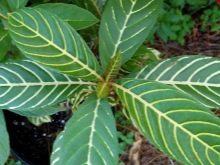

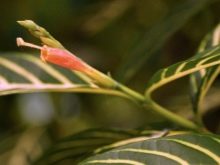
There are many species and varieties of this bright perennial. This ornamental plant attracts a lot of attention thanks to its expressive foliage. The shrub itself grows relatively small when grown at home. Its height parameter can reach values of 1-1.5 m.
Under natural conditions, Sanchezia grows in areas where a humid climate persists. The main distribution area of the shrub is Central and South America. At home, most often only one of the species is grown, namely the noble sanchetia.
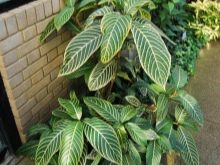
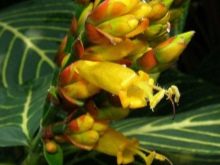

The leaf plates of the considered ornamental plant are rather large. They are characterized by a high degree of density, have smooth veins of yellow, white or cream shades. The parameter of the length of the foliage of the sanchezia can reach 30 cm.
Sanchezia is not a common and popular houseplant. It is growing at a very high rate. Every year, 7 new leaves are formed on the shoots of the tetrahedral shape. Usually the plant blooms in the summer. The flowers have a tubular structure and are collected in spike-shaped inflorescences.
The plant in question is thermophilic, likes to receive a sufficient amount of light. Its tubular flowers usually reach a length of 5 cm. The stems of this shrub develop rather fleshy and soft. They are characterized by a tetrahedral section. Under natural conditions, the stems of the Sanchezia exhibit a neat pinkish coloration. With age, these parts of the plant become darker, certainly lignified.
In nature, small hummingbirds are engaged in pollination of Sanchezia. This suggests that the fertilization process does not take place directly in the culture, the seeds are not set.

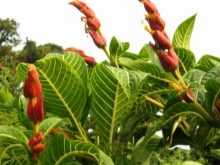

Types and varieties
There are many different types and varieties of sanchezia. Let's take a closer look at the characteristics and features of the most common specimens.
Noble
Sanchezia noble looks very attractive and decorative. It's hard not to pay attention to her. The height of the shrub in question usually reaches a mark of about 2 meters. The foliage of the noble flower develops large and very bright, with a characteristic green color. There are interesting lemon streaks on the leaf blades. The shape of the leaves is elliptical.
The shoots of the plant are tetrahedral. On them, the foliage is located in parallel, marked by a pronounced gloss. The flowers of the bush are yellow in color, gather in inflorescences of impressive length - spikelets.
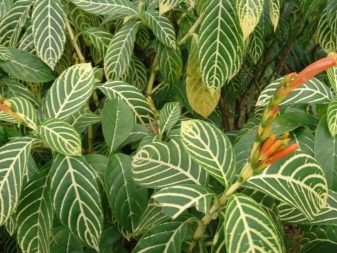
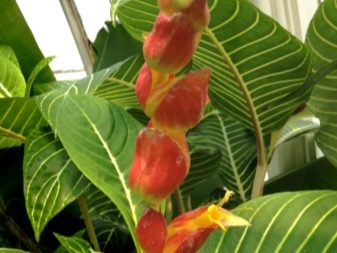
Small covering
The specified type of shrub can grow more than 0.9 m in length. The shoots of the plant have a thickened structure, painted in a rich brown shade. The foliage of the bush has an interesting and very expressive design - it is characterized by an elongated elliptical shape, demonstrates an emerald color.In addition, there are thin golden streaks on the leaves. At the same time, the middle vein located in the lower half has a red color different from the rest.
The considered shrub variety is characterized by an original appearance. It is often used for creative decoration of various environments and interiors.
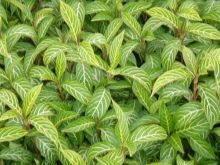
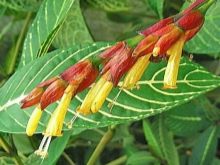
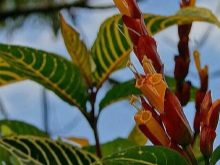
Planting and leaving
Many people are interested in whether it is possible to plant and grow sanchetia at home. Of course, it is possible to do this, but for this it is very important to provide the plant with optimal air temperature and humidity. Only if this simple condition is met, the planting will turn into a beautiful and large bush, decorated with lush foliage with a bright contrasting pattern.
To grow sanchezia at home, it is important to choose a well-lit indoor location for this. However, in the summer season, direct sunlight should be prevented so that the plant does not suffer from this. It is important to provide the bush with the proper level of shading. To do this, you can use the usual tulle.
The best spots with adequate light are usually located in the vicinity of the areas where the sun's rays fall. Such "squares" will be optimal for placing sankhetsia on them.
It should be borne in mind that the original tropical flower is not designed for strong and cold drafts, so they should be avoided. At the same time, the room in which the plant is located cannot be left without ventilation. For refreshment in the winter season, it is advisable to choose warmer days. It is best to open the window for a short time - 15–20 minutes will be enough.
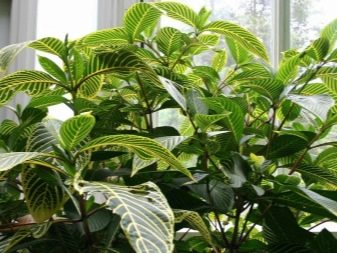

The optimal temperature indicator for sanchezia is from +18 to +25 degrees Celsius. Such values should not drop sharply or, conversely, jump over an extended period of time. If the temperature rises, the foliage may turn yellow and dry out. Temperature values that are too low will cause the leaves of the bush to become too soft and flabby.
For sankhetia, average or slightly increased humidity is optimal - 50-70%. Against the background of the heating season, the natural level of humidity in the apartment will be insufficient for most indoor plants. The situation is aggravated even more if the flower is too close to the radiators. Dried air can cause dry foliage to form, so it is very important to maintain air humidity by spraying liquid from a spray bottle. It is also allowed to install automatic humidifiers next to plants.
After planting, the plant must be properly cared for. Sanchezia requires a lot of moisture, especially from March to November. In this case, the irrigation water must have a temperature that will not be lower than room temperature, otherwise the bush may survive a "temperature shock". In the intervals between watering the plant, the top layer of the soil mixture should dry out a little.
It is important to ensure that the soil is not dry for a long time.


Sanchezia needs abundant watering. It is necessary to ensure that the soil ball is completely moistened. In this case, water should flow out of the drainage holes, accumulating in the sump. Excess liquid will collect there for about 20 minutes after watering is complete. Then you just need to pour it out. It is important not to allow moisture to accumulate on the lower tier of the pot with a bush. In order not to face such a problem, a drainage layer should be placed on the bottom of the tank, the thickness of which is at least 2 cm.
The best drainage is obtained from expanded clay or shards from ceramic dishes. Even the most water-loving plants can be seriously damaged if their roots are left in wet conditions for long periods of time. This can lead to root rot.

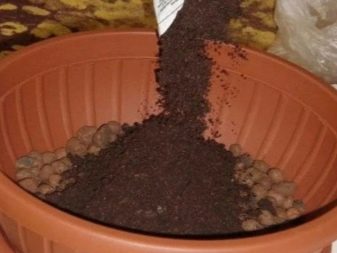
It is best to water the sanchezia at the root.In this case, you still need to moisten the sheet plates using a spray bottle. You can also resort to the lower type of irrigation. In this case, the liquid must be poured into the sump. Moisture will be gradually sent to the roots of the bush through the drainage holes.
During the winter season, the plant should be watered sparingly. You need to use a liquid at room temperature. The flower needs to be given so much water so that the soil mixture in the pot is moistened evenly, but at the same time it is not oversaturated with water too much.
From spring to autumn, the plant must be fed. Every fourth watering should be done with fertilization. The latter should be bred based on the manufacturer's recommendations. In the winter season, they need to be added less. So, from November to March, it is enough to sell 1-2 additional fertilizing per month. Before applying any formulations, the soil in the pot must be slightly moistened.

Correct pruning is also important for sanchezia. The plant tolerates this procedure without problems. When pruning, overly long shoots are shortened by 2/3 of their original parameters. This is done by means of a sharp knife with a disinfected blade. Instead of a knife, it is also allowed to use pruning shears or special garden shears.
The flower may also need a transplant. Such work should be done if:
- the pot has become too small for a flower;
- the drainage layer has settled or become too dense;
- the container is completely entwined with roots;
- the roots make their way to the surface from the soil mixture.

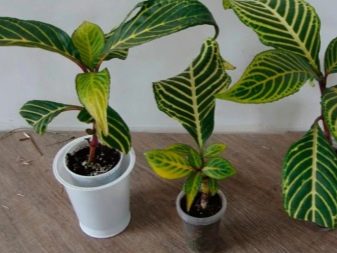
Reproduction
In early spring, the flower can be propagated through the cuttings procedure.
- The upper parts of the stems can be used as cuttings. They must have at least 3 knots. The cut is made 1 cm under the third knot.
- Cuttings should be planted in the substrate by 1/3. A compact seedling box should be used. It must be filled with a mixture of equal volumes of peat and sand. The optimum temperature of the soil mixture is from +20 to +25 degrees Celsius.
- The cuttings mixture will need moderate watering.
- Pull a polyethylene film over the box. The tank should be placed in a bright, but not very sunny place.
- Every 3 days, the film is opened for 15 minutes to ventilate the soil.
- Once the petioles are well rooted, they can be transplanted into separate pots.
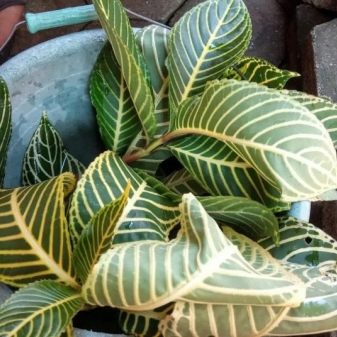

Diseases and pests
We will find out what ailments and pests most often affect the sanchetia.
- The plant is very fond of various parasites. Most often, sanchezia suffers from aphids, whiteflies, spider mites, scale insects, mealybugs. With such problems, the bush is treated with insecticides.
- If the air humidity is reduced, the ends of the sheets dry out.
- It so happens that the foliage of the plant begins to fall off. This can be triggered by the dryness of the soil mixture, excessive lighting, or insufficient moisture in the air around the flower.
- Brown spots may appear on foliage due to sun damage.
- Decreased temperatures and high humidity can lead to rotting of both the stems and leaf plates of the ornamental shrub.
- There are situations in which the sanchetia develops very slowly, and its leaves do not grow large. Usually, such troubles occur if the plant does not receive enough of the necessary nutrients and substances.

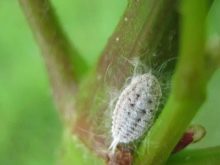
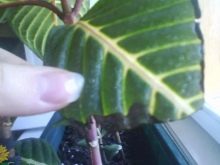































The comment was sent successfully.